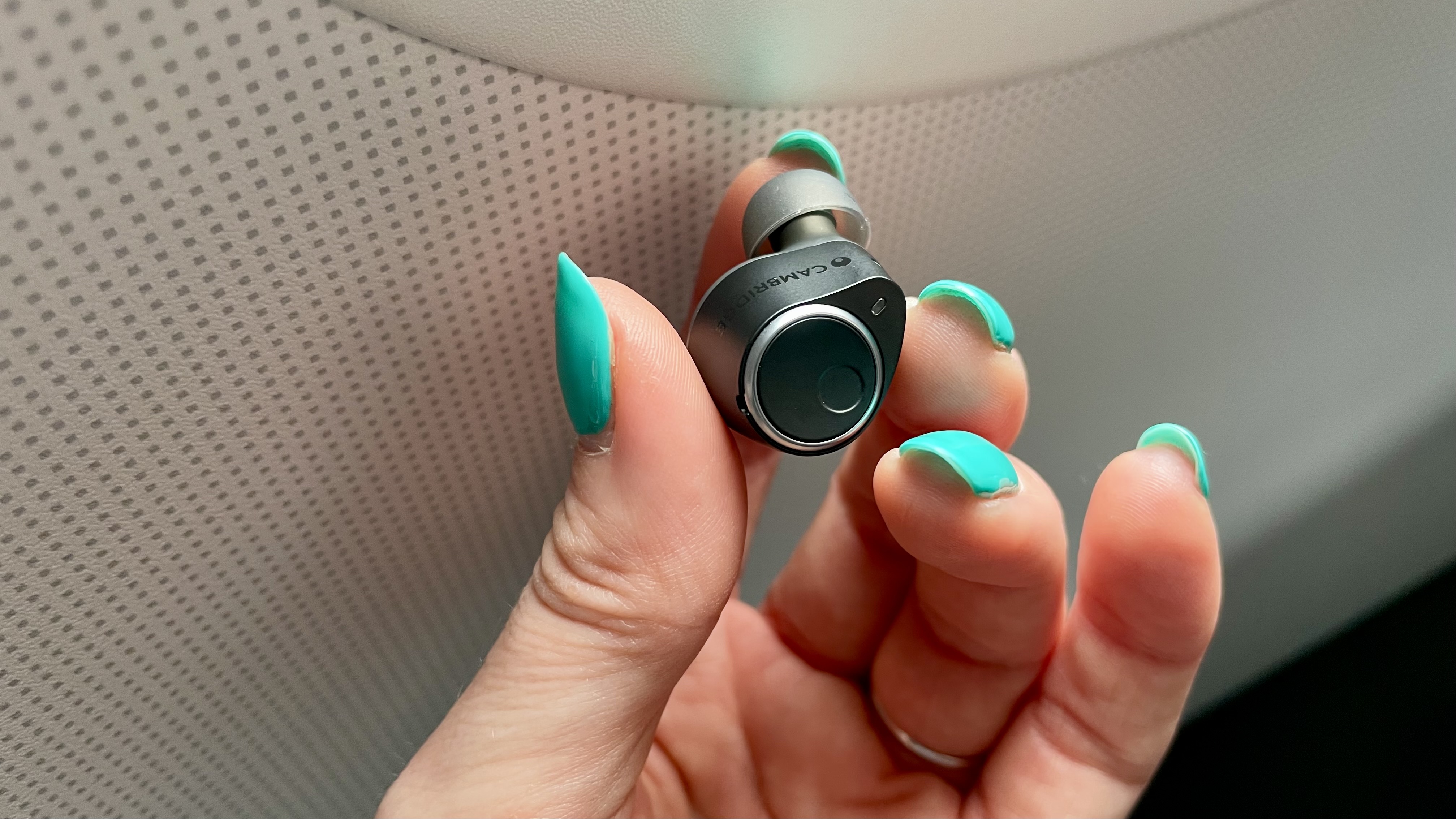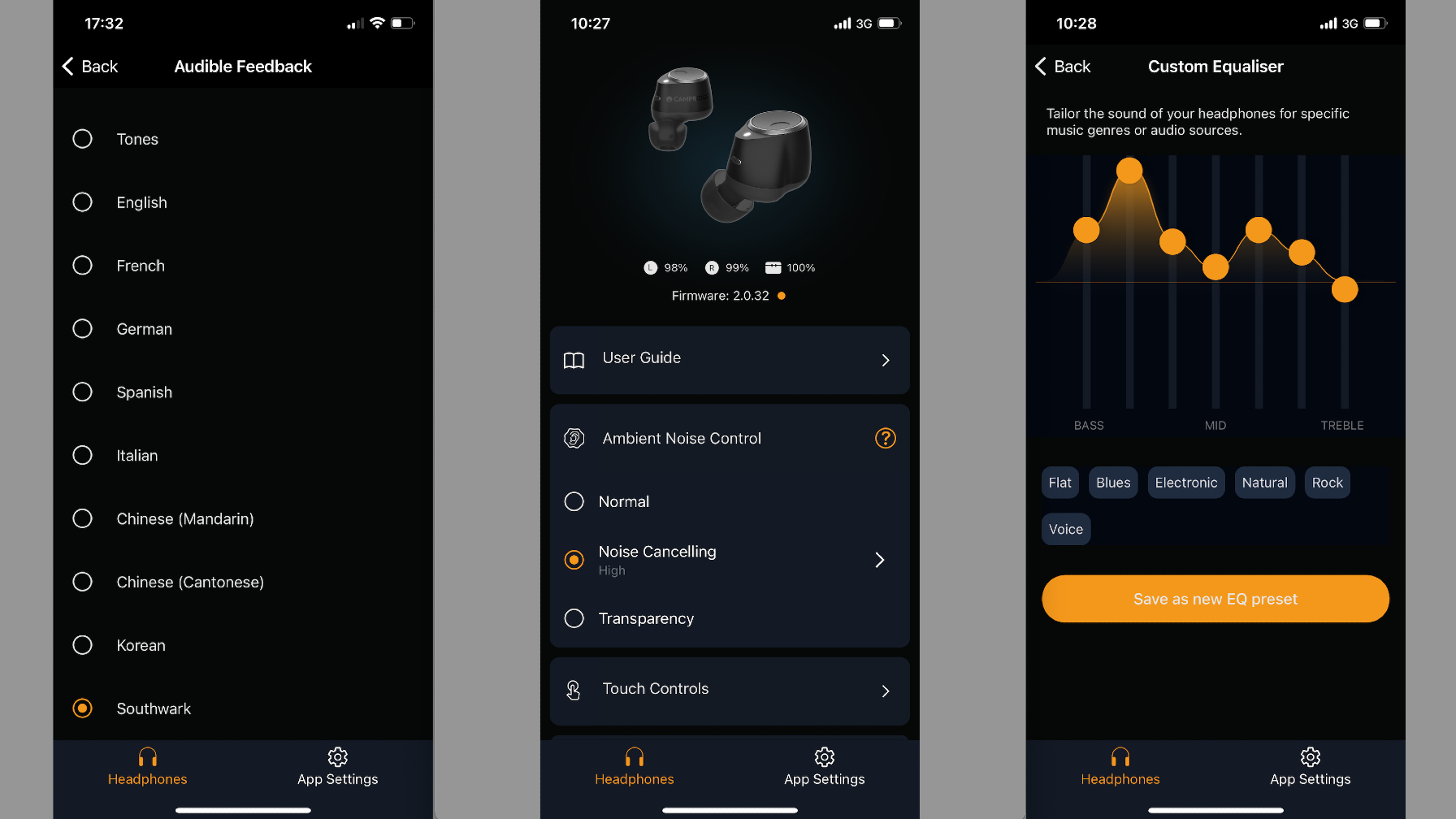
Cambridge Audio Melomania M100: Two-minute review
The Cambridge Audio Melomania M100 are what the fans were waiting for. Prior to their release, Cambridge Audio's excellent earbuds couldn't join the ranks of the best noise-cancelling earbuds for one simple reason: the UK audio specialist's true wireless buds sounded fantastic, but they didn't have the necessary antiphase noise-nixing tech onboard to offer active noise cancellation. And that is because Cambridge Audio prefers to focus on excellent audio quality (and long may that last by the way).
But times have changed. While Melomania will never cease to mean 'crazy about music', the British company has conceded that the people are also crazy about active noise cancellation. And if Cambridge is going to offer ANC, it's going to do it right. Although you can't tweak its splendid noise cancelling profile any further than 'On', 'Off' or 'Transparency', when it's on, the ANC here is as effective at cancelling low-level noise as you could wish for, cocooning me in a bubble of near-silence and keeping the footsteps around my desk (plus my own tap-tap-tapping of the laptop keys upon which I bring you this review) barred from that bubble.
The transparency profile is less useful, with a bit too much audible feedback and a near-constant quiet hiss, even in quiet environments, to be a wholly pleasant experience. But a less-than-perfect transparency mode is a minor shortfall I'm prepared to accept when the noise nixing is this good.
Multi-point connectivity is baked in here, as is aptX Lossless and aptX Adaptive for higher-resolution audio (if you've got a decent, paid-for music streaming subscription and files up to 24bit/96kHz to serve them), and the battery life, at up to 10 hours from the buds and a total of 23 with ANC on, or 16 hours from the buds and 36 with ANC off, is exceptional. The build quality is also bang-on, with a far more ergonomic driver housing than the bullet-shaped Melomania 1 Plus.
There's no device-agnostic spatial audio special side-sauce or fit tests and I'm not surprised. I can hear Cambridge Audio's engineers reaffirm the choice to offer "as few opportunities as possible to muck around with your music – we like a clean sound", as they did at the launch of the excellent CXN100 Network Player in January 2024. And you know what? I really don't mind, because the sound in these earbuds is expansive, detailed, nuanced, clean, neutral and immersive enough all by itself. That said, Cambridge will let you select one of six EQ presets, or create a custom one of your own – with a seven-point EQ parametric tab.
Call handling is also very good, thanks to the Qualcomm's three mic cVc (or Clear Voice Capture) solution, designed to separate your voice from environmental noise, which works very well indeed.
I should mention that the case is a little big – again, I'm OK with this more substantial box given the excellent stamina, sound quality and ANC. Also, they're perhaps $50 or £40 pricier than the direct competition. Are they worth it? It all comes down to whether you prioritise sound quality above all else in a true wireless design. For me, the Melomania M100 represent sound-per-pound value – but if you want fit tests, tailored otoacoustic hearing profiles and other whistles and bells, you won't want these.
Cambridge Audio Melomania M100 review: Price and release date

- Released on March 27, 2024
- Priced at $219 / £169 / AU$299
The Cambridge Audio M100 aren't as cheap as the Melomania 1 Plus earbuds they succeed, which had a launch price of $139.95 / £119.95 / about AU$185 – although their price has dropped significantly since that.
At £169 (about $219 / AU$326) they're still considerably more affordable than AirPods Pro 2, which typical sell for $249 / £249 / AU$399. While you could argue that Apple sets a pretty high bar and most brands undercut that pricing, that's not necessarily true in 2024. Consider Bose's $299 / £299 / AU$449 Bose QuietComfort Ultra, Sennheiser's March 2024 $299 / £259 / AU$479 Sennheiser Momentum True Wireless 4 or Technics' EAH-AZ80, also at $299 / £259 / AU$499. See? For the level, Cambridge Audio has actually priced these earbuds competitively.
What you need to know is that while there's plenty of flagship talent here, they actually come in slightly under flagship money. The Melomania M100 are not as affordable as the excellent Nothing Ear (a), for example, but the Nothing buds are an entry-level proposition – a great proposition, but missing just one or two of the flagship features you'll find in their top-tier Nothing Ear counterparts.
Cambridge Audio Melomania M100 review: Specs
Cambridge Audio Melomania M100 review: Features

- Great active noise cancellation and app support
- Excellent battery life
- Use the 'Southwark' Audible Feedback profile
The fact that Cambridge Audio has included active noise-cancellation (ANC) plus a Transparency mode is big news, because it's a first for the UK audio outfit's Melomania lineup – but the even bigger news is, the noise nixing works really well. At my desk, I'm living in a bubble of near-silence akin to that afforded by the AirPods Pro 2, and that's not a statement I make lightly.
You're also getting Bluetooth 5.3 with LE Audio, aptX Lossless for CD-like audio quality, Auracast (for when broadcast audio-sharing comes to our airports and waiting rooms), plus the more efficient LC3 codec.
Call handling is a breeze using the Melomania M100's three mics per earpiece (kitted out with cVc echo-cancelling and noise suppression tech from Qualcomm) and the battery life here is very impressive, with a possible 52 hours from the buds and charging case combined – because you get 16 hours from the buds alone if you keep ANC turned off. For clarity, the AirPods Pro 2 last 'just' nine hours with ANC off (I know this because I tested it myself).
Melomania Connect is the M100's capable (and newly updated) companion app, which opens the door to additional features such as the ability to customise the on-ear controls to your liking, six EQ presets plus a seven-band graphic equaliser so you can create your own, wearer detect to pause audio when you remove one, mono audio (if you've given one bud to a friend), a sleep mode (which disables all touch controls and voice prompts until you put them back in their case) a gaming mode to reduce latency when watching videos and my favorite, the chance to select what Cambridge calls 'Audible feedback'. This, it turns out, means the person talking to you in your headphones about pairing status, noise cancellation and so on. Scroll down to 'Southwark' in this tab and you hear none other than the actual Matt Berry (What We do in the Shadows; Toast of London; The IT Crowd). And that, truly, is an ace up Cambridge Audio's sleeve. If you don't believe me, just spend a few moments setting up multipoint.
There’s no special spatial audio processing (which doesn't surprise me given Cambridge Audio's thoughts on keeping music authentic and as the artist intended), but some users may miss the fit tests and even tailored profiles based on your hearing offered by the Denon PerL Pro and Nothing's new Ear (a), to name just two products that offer it – because you won't find these in the M100.
- Features score: 4/5
Cambridge Audio Melomania M100 review: Sound quality

- Expansive, detailed presentation
- Sublime clarity across the frequencies
- Just a shade off excellent for dynamic nuance
You can of course listen to lossy Spotify tracks using the Melomania M100, but Cambridge Audio's focus has long been sound quality and as such, you might want to treat these buds to some higher-resolution Apple Music, Qobuz or Tidal streams. Also when you do, there's so much to love.
When streaming The Bangles' Eternal Flame, Susanna Hoffs' stunningly understated vocal is given a few inches more space to shine than I'm used to at this level, and backing vocals arrive in each ear with surprising texture and clarity through the lower mids. Travis Scott's FE!N is immersive as synths dart between each ear, proving that the M100 aren't afraid to drop low and get grimy either.
Belle and Sebastian's She's Losing It is another sonic delight for neutrality and detail in each musical passage; you'll feel as if you learned a bit about this Glaswegian indie band's use of strings and additional voices after a session with the Melomania M100.
Sam Smith's Unholy reveals a minor shortfall in terms of dynamic nuance though. The M100s still serve up a detailed and cohesive mix, but I'm missing an extra ounce of the spirited rise and fall that typifies the track. This is a song that grabs you from the get-go, with a full choral recital of the main theme followed by a moment of silence before the bass-riff drops. It's just not quite as ear-grabbing, zealous or petulant as I've heard prior to now.
Again, it's a long way from an actual issue – and many listeners will prefer the expansive, integrated, detailed, thoughtful presentation of the Cambridge Audio Melomania M100. I adore listening to Melissa Etheridge's I Want to Come Over with these earbuds, since I can hear her particular method of approaching guitar strings in ballads and the beautiful, imperfect textures in her vocal at times, but if you tend to listen to hip-hop and grime tracks on the commute, you may just yearn for a little extra oomph.
- Sound quality score: 4.5/5
Cambridge Audio Melomania M100 review: Design

- Ergonomic, secure and comfortable earpieces
- On-ear controls work well
- Case is a little big
These are easily the most comfortable Melomania earbuds ever made. The buds slip easily into my shell-likes with none of the tiresome twist-and-lock screwing them in some earbuds require. At 6.65g per bud, they're not particularly light given the competition (Sony's LinkBuds S weigh just 4.8g, for example), but they're beautifully well-weighted and the design feels like it wants to hug your ear and stay put, which is always helpful.
OK, the case is on the large side, plastic, and other options look a little more premium for the price, but it is perfectly durable and pocketable. Unless you're lucky enough to bag a limited edition How High pair (which comes in a bright yellow and black color scheme – a nod to the music video for The Charlatans' hit How High, in which singer Tim Burgess wore a bright yellow jacket) the M100 is available in black with more black only, so if you wanted something in white or silver, you won't find it here.
That's not to say I don't like the design; I do. The central touch-capacitive 'button' (you don't actually have to depress it) on the top plate of each driver housing is easy to find has a nice tactile edge to it and is a chic nod to Cambridge Audio's circle-within-a-circle logo. The controls also work very well indeed and each function can be toggled on or off if you won't use it. I like that I can have Matt Berry announcing the ANC profiles when I tap the left earbud, while play-and-pause is a single tap of the right, and the on-ear volume control is handled by a long press of either bud (left to decrease; right to increase) which is always the best solution I find – because perfecting three or four taps so that your earbuds actually understand and respond accordingly is a big ask.
- Design score: 4.5/5
Cambridge Audio Melomania M100 review: Voice prompts

- Select 'Southwark' and you get Matt Berry
- No really, it's actually Matt Berry
In case it hasn't been mentioned enough (and I feel it can never be overstated, so sub editor, please leave this in), by heading to the 'Audible feedback' tab in the app, scrolling all the way to the bottom and selecting the unassuming 'Southwark' option, the dulcet tones of Matt Berry will greet your ear. He'll serve up delectable vocal morsels such as "Device one, connected" or "Waiting to pair" depending on how you're using them, in addition to the standard "Noise cancelling", "Normal" or "Transparency" and if you're a fan of Matt Berry's sizeable oeuvre, it's priceless. It's almost like having Steven Toast at your beck and call. ("Hello Steven, can you hear me? It's Clem Fandango…")
- Voice prompts score: 6/5
Cambridge Audio Melomania M100 review: Value
- As feature-packed as any earbuds has any business being for the money
- A no-brainer for Tidal members
- Unbeatable for comfort and sound-quality at the level
For features, noise cancellation and sound quality, these are a compelling set of earbuds – but them and you will not be disappointed with the levels of detail in your music and the near-silence they'll add as a backdrop if you want it.
The AirPods Pro 2 will give you a little more dynamic zeal, and Denon's PerL Pro will offer hearing tests and tailored sonic profiles. That said, both rivals will charge you a little more for it.
Cambridge Audio's focus here has been on detail, clarity and effective ANC. If those requirements are top of your list, these may well be the buds for you.
- Value score: 4/5
Should I buy the Cambridge Audio Melomania M100?
Buy them if...
Don't buy them if...
Cambridge Audio M100 review: Also consider
How I tested the Cambridge Audio Melomania M100
- Tested for two weeks, listened against the Technics EAH-AZ80, AirPods Pro 2 and Bose QuietComfort Ultra Earbuds
- Used at work (in the office; walking through London; on a train) and at home
- Listened to Tidal, Apple Music Lossless, Qobuz tracks and Spotify on an iPhone 12 Pro, a Samsung Galaxy S22 and a MacBook Pro
It will come as no surprise to learn that the Cambridge Audio Melomania M100 became my musical companions for two weeks – after a thorough 48-hour run-in period. How else am I to test them?
They accompanied me to work on weekdays walking (and on more than one occasion, running) to the station; boarding a train and on the London Underground; at the office. They also stayed in my ears during long walks on the UK's Jurassic Coast, in Dorset – a great way to test any wind-interference from mics during calls.
To better test the battery life and comfort levels of the Cambridge Audio Melomania M100, I wore them throughout the working day and into a yoga class in the evening – and they outlasted my working day by some distance.
To test the audio quality across the frequencies, I listened to our reference playlist but also my own music (spanning everything from country to classical) on Apple Music, Qobuz and Tidal, but also to podcasts and albums on Spotify – and YouTube tutorials (mostly about silversmithing, if you're curious) from my MacBook Pro.
I’ve been testing audio products for over five years now. As a dancer, aerialist and musical theater performer in another life, sound quality, fit and the user experience have always taken priority for me personally – but having heard how wonderful ANC can be when done well, I know what to look for.







